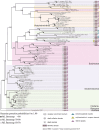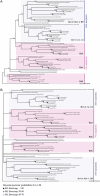Intrinsic apoptosis is evolutionarily divergent among metazoans
- PMID: 38525035
- PMCID: PMC10959488
- DOI: 10.1093/evlett/qrad057
Intrinsic apoptosis is evolutionarily divergent among metazoans
Abstract
Apoptosis is regulated cell death that depends on caspases. A specific initiator caspase is involved upstream of each apoptotic signaling pathway. Characterized in nematode, fly, and mammals, intrinsic apoptosis is considered to be ancestral, conserved among animals, and depends on shared initiators: caspase-9, Apaf-1 and Bcl-2. However, the biochemical role of mitochondria, the pivotal function of cytochrome c and the modality of caspase activation remain highly heterogeneous and hide profound molecular divergence among apoptotic pathways in animals. Uncovering the phylogenetic history of apoptotic actors, especially caspases, is crucial to shed light on the evolutionary history of intrinsic apoptosis. Here, we demonstrate with phylogenetic analyses that caspase-9, the fundamental key of intrinsic apoptosis, is deuterostome-specific, while caspase-2 is ancestral to bilaterians. Our analysis of Bcl-2 and Apaf-1 confirms heterogeneity in functional organization of apoptotic pathways in animals. Our results support emergence of distinct intrinsic apoptotic pathways during metazoan evolution.
Keywords: cell death evolution; initiator caspases; intrinsic apoptosis; phylogeny.
© The Author(s) 2023. Published by Oxford University Press on behalf of The Society for the Study of Evolution (SSE) and European Society for Evolutionary Biology (ESEN).
Figures






Similar articles
-
Evolution of Apoptotic Signaling Pathways Within Lophotrochozoans.Genome Biol Evol. 2024 Oct 9;16(10):evae204. doi: 10.1093/gbe/evae204. Genome Biol Evol. 2024. PMID: 39318156 Free PMC article.
-
The initiator caspase, caspase-10beta, and the BH-3-only molecule, Bid, demonstrate evolutionary conservation in Xenopus of their pro-apoptotic activities in the extrinsic and intrinsic pathways.Genes Cells. 2006 Jul;11(7):701-17. doi: 10.1111/j.1365-2443.2006.00983.x. Genes Cells. 2006. PMID: 16824191
-
Functional conservation of the apoptotic machinery from coral to man: the diverse and complex Bcl-2 and caspase repertoires of Acropora millepora.BMC Genomics. 2016 Jan 16;17:62. doi: 10.1186/s12864-015-2355-x. BMC Genomics. 2016. PMID: 26772977 Free PMC article.
-
Apoptosis: checkpoint at the mitochondrial frontier.Mutat Res. 1999 Jul 30;434(3):243-51. doi: 10.1016/s0921-8777(99)00032-4. Mutat Res. 1999. PMID: 10486595 Review.
-
Initiator caspases in apoptosis signaling pathways.Apoptosis. 2002 Aug;7(4):313-9. doi: 10.1023/a:1016167228059. Apoptosis. 2002. PMID: 12101390 Review.
Cited by
-
PI3K-AKT-mediated phosphorylation of Thr260 in CgCaspase-3/6/7 regulates heat-induced activation in oysters.Commun Biol. 2024 Nov 7;7(1):1459. doi: 10.1038/s42003-024-07184-4. Commun Biol. 2024. PMID: 39511363 Free PMC article.
-
Apoptotic Factors Are Evolutionarily Conserved Since Mitochondrial Domestication.Genome Biol Evol. 2023 Oct 6;15(10):evad154. doi: 10.1093/gbe/evad154. Genome Biol Evol. 2023. PMID: 37616576 Free PMC article.
-
Evolution of Apoptotic Signaling Pathways Within Lophotrochozoans.Genome Biol Evol. 2024 Oct 9;16(10):evae204. doi: 10.1093/gbe/evae204. Genome Biol Evol. 2024. PMID: 39318156 Free PMC article.
-
Evolution of Caspases and the Invention of Pyroptosis.Int J Mol Sci. 2024 May 12;25(10):5270. doi: 10.3390/ijms25105270. Int J Mol Sci. 2024. PMID: 38791309 Free PMC article. Review.
-
Cell death in bryophytes: emerging models to study core regulatory modules and conserved pathways.Ann Bot. 2024 Aug 22;134(3):367-384. doi: 10.1093/aob/mcae081. Ann Bot. 2024. PMID: 38953500 Free PMC article. Review.
References
-
- An, H. -K., Chung, K. M., Park, H., Hong, J., Gim, J. -E., Choi, H., Lee, Y. W., Choi, J., Mun, J. Y., & Yu, S. -W. (2020). CASP9 (caspase 9) is essential for autophagosome maturation through regulation of mitochondrial homeostasis. Autophagy, 16(9), 1598–1617. 10.1080/15548627.2019.1695398 - DOI - PMC - PubMed
-
- Aubrey, B. J., Janic, A., Chen, Y., Chang, C., Lieschke, E. C., Diepstraten, S. T., Kueh, A. J., Bernardini, J. P., Dewson, G., O’Reilly, L. A., Whitehead, L., Voss, A. K., Smyth, G. K., Strasser, A., & Kelly, G. L. (2018). Mutant TRP53 exerts a target gene-selective dominant-negative effect to drive tumor development. Genes & Development, 32(21-22), 1420–1429. 10.1101/gad.314286.118 - DOI - PMC - PubMed

